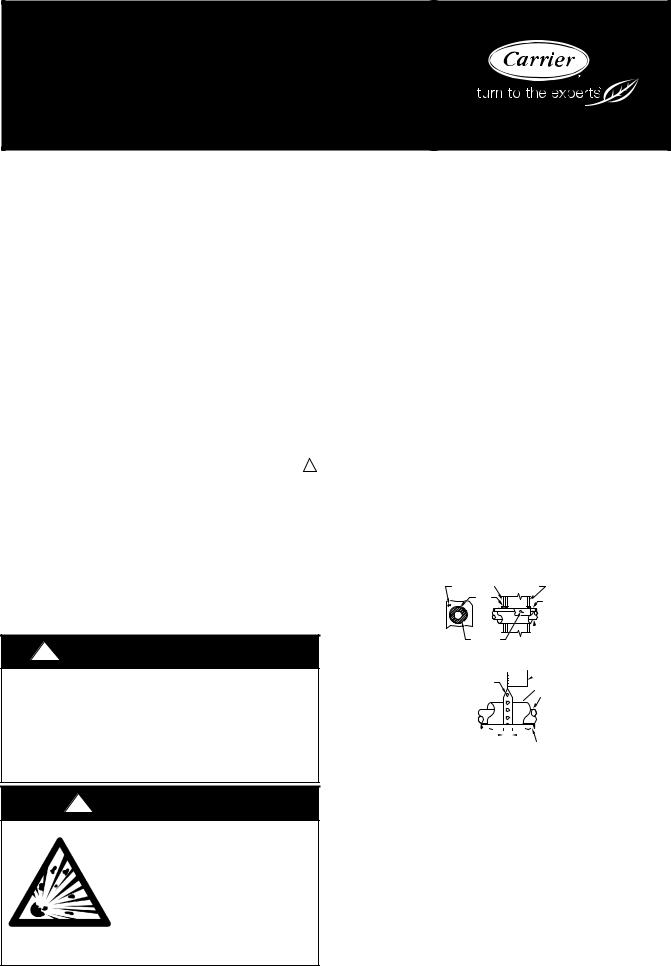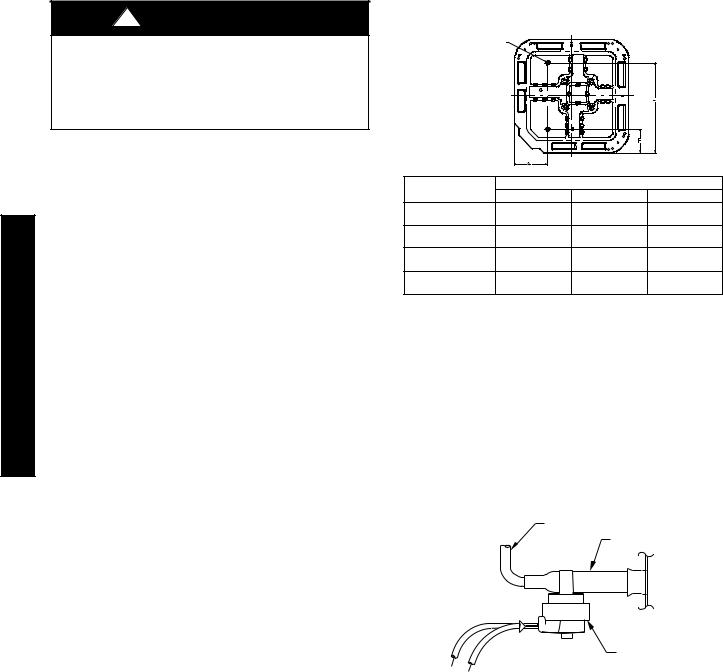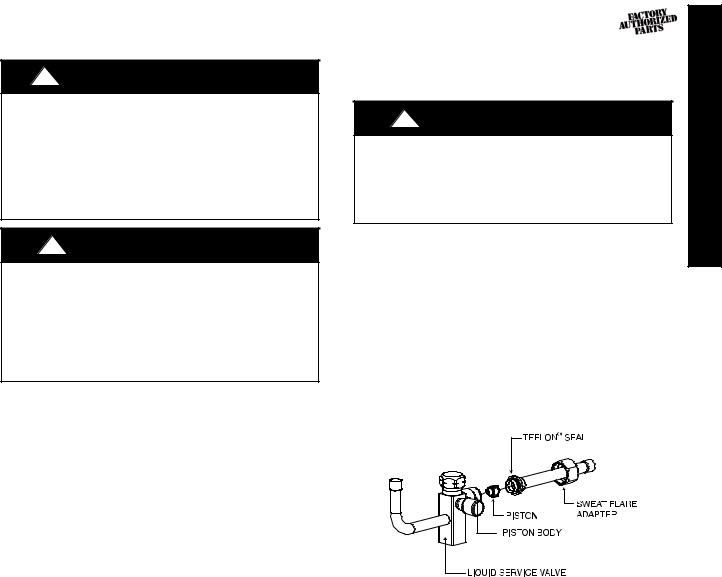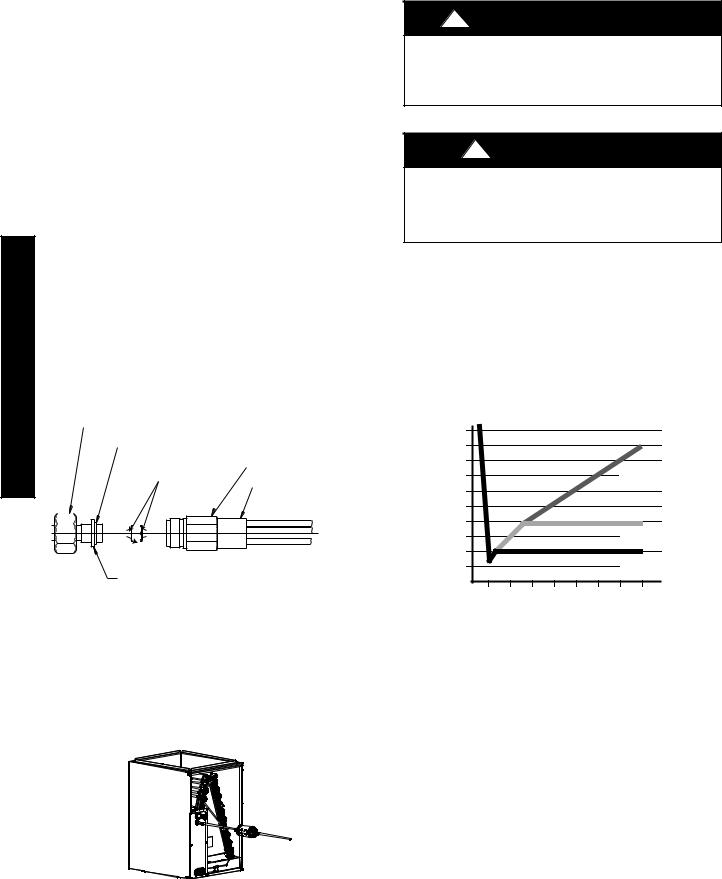Carrier 25HCD Quick Start Manual

25HBB, 25HBC, 25HCD Comfortt Series Heat Pumps with Puronr Refrigerant
1–1/2 To 5 Nominal Tons
Installation Instructions
NOTE: Read the entire instruction manual before starting the installation.
SAFETY CONSIDERATIONS
Improper installation, adjustment, alteration, service, maintenance, or use can cause explosion, fire, electrical shock, or other conditions which may cause death, personal injury, or property damage. Consult a qualified installer, service agency, or your distributor or branch for information or assistance. The qualified installer or agency must use factory–authorized kits or accessories when modifying this product. Refer to the individual instructions packaged with the kits or accessories when installing.
Follow all safety codes. Wear safety glasses, protective clothing, and work gloves. Use quenching cloth for brazing operations. Have fire extinguisher available. Read these instructions thoroughly and follow all warnings or cautions included in literature and attached to the unit. Consult local building codes and current editions of the National Electrical Code (NEC) NFPA 70. In Canada, refer to current editions of the Canadian electrical code CSA 22.1.
Recognize safety information. This is the safety–alert symbol !! . When you see this symbol on the unit and in instructions or manuals, be alert to the potential for personal injury.
Understand these signal words; DANGER, WARNING, and CAUTION. These words are used with the safety–alert symbol. DANGER identifies the most serious hazards which will result in severe personal injury or death. WARNING signifies hazards which could result in personal injury or death. CAUTION is used to identify unsafe practices which may result in minor personal injury or product and property damage. NOTE is used to highlight suggestions which will result in enhanced installation, reliability, or operation.
!WARNING
ELECTRICAL SHOCK HAZARD
Failure to follow this warning could result in personal injury or death.
Before installing, modifying, or servicing system, main electrical disconnect switch must be in the OFF position. There may be more than 1 disconnect switch. Lock out and tag switch with a suitable warning label.
!WARNING
EXPLOSION HAZARD
Failure to follow this warning could result in death, serious personal injury, and/or property damage.
Never use air or gases containing oxygen for leak testing or operating refrigerant compressors. Pressurized mixtures of air or gases containing oxygen can lead to an explosion.
INSTALLATION RECOMMENDATIONS
NOTE: In some cases noise in the living area has been traced to gas pulsations from improper installation of equipment.
1.Locate unit away from windows, patios, decks, etc. where unit operation sound may disturb customer.
2.Ensure that vapor and liquid tube diameters are appropriate for unit capacity.
3.Run refrigerant tubes as directly as possible by avoiding unnecessary turns and bends.
4.Leave some slack between structure and unit to absorb vibration.
5.When passing refrigerant tubes through the wall, seal opening with RTV or other pliable silicon–based caulk (see Fig. 1).
6.Avoid direct tubing contact with water pipes, duct work, floor joists, wall studs, floors, and walls.
7.Do not suspend refrigerant tubing from joists and studs with a rigid wire or strap which comes in direct contact with tubing (see Fig. 1).
8.Ensure that tubing insulation is pliable and completely surrounds vapor tube.
9.When necessary, use hanger straps which are 1 in. wide and conform to shape of tubing insulation (see Fig. 1).
10.Isolate hanger straps from insulation by using metal sleeves bent to conform to shape of insulation.
OUTDOOR WALL |
|
INDOOR WALL |
CAULK
LIQUID TUBE
 SUCTION TUBE
SUCTION TUBE
INSULATION
THROUGH THE WALL
 JOIST
JOIST
HANGER STRAP
(AROUND SUCTION
TUBE ONLY) 
 INSULATION
INSULATION 
 SUCTION TUBE
SUCTION TUBE
|
|
|
|
|
|
|
|
|
|
|
|
|
1” (25.4 mm) |
|
|
|
|
|
|
|
|
|
|
|
|
MIN |
|
|
|
|
|
|
|
|
|
|
LIQUID TUBE |
|
|
|
|
|
|
|
|
|
|
|
|||
|
|
SUSPENSION |
||||||||||
A07588
Fig. 1 - Connecting Tubing Installation
When outdoor unit is connected to factory–approved indoor unit, outdoor unit contains system refrigerant charge for operation with AHRI rated indoor unit when connected by 15 ft. (4.57 m) of field–supplied or factory accessory tubing. For proper unit operation, check refrigerant charge using charging information located on control box cover and/or in the Check Charge section of this instruction.
IMPORTANT: Maximum liquid–line size is 3/8–in. OD for all residential applications including long line.
IMPORTANT: Always install the factory–supplied liquid–line filter drier. Obtain replacement filter driers from your distributor or branch.

25HBB / 25HBC / 25HCD
INSTALLATION
!CAUTION
CUT HAZARD
Failure to follow this caution may result in personal injury.
Sheet metal parts may have sharp edges or burrs. Use care and wear appropriate protective clothing and gloves when handling parts.
Check Equipment and Job Site
Unpack Unit
Move to final location. Remove carton taking care not to damage unit.
Inspect Equipment
File claim with shipping company prior to installation if shipment is damaged or incomplete. Locate unit rating plate on unit corner panel. It contains information needed to properly install unit. Check rating plate to be sure unit matches job specifications.
Install on a Solid, Level Mounting Pad
If conditions or local codes require the unit be attached to pad, tie down bolts should be used and fastened through knockouts provided in unit base pan. Refer to unit mounting pattern in Fig. 2 to determine base pan size and knockout hole location.
For hurricane tie downs, contact distributor for details and PE Certification (Professional Engineer), if required.
On rooftop applications, mount on level platform or frame. Place unit above a load–bearing wall and isolate unit and tubing set from structure. Arrange supporting members to adequately support unit and minimize transmission of vibration to building. Consult local codes governing rooftop applications.
Roof mounted units exposed to winds above 5 mph may require wind baffles. Consult the Service Manual – Residential Split System Air Conditioners and Heat Pumps for wind baffle construction.
NOTE: Unit must be level to within ±2° ( 3/8 in/ft, 9.5 mm/m) per compressor manufacturer specifications.
Clearance Requirements
When installing, allow sufficient space for airflow clearance, wiring, refrigerant piping, and service. Allow 24 in. (609.6 mm) clearance to service end of unit and 48 in. (1219.2 mm) (above unit. For proper airflow, a 6–in. (152.4 mm) clearance on 1 side of unit and 12–in. (304.8 mm) on all remaining sides must be maintained. Maintain a distance of 24 in. (609.6 mm) between units or 18 in. (457.2 mm) if no overhang within 12 ft. (3.66 m). Position so water, snow, or ice from roof or eaves cannot fall directly on unit.
NOTE: 18” (457.2 mm) clearance option described above is approved for outdoor units with wire grille coil guard only. Units with louver panels require 24” (609.6 mm) between units.
On rooftop applications, locate unit at least 6 in. above roof surface.
3/8–in. (9.53 mm) Dia. Tiedown Knockouts in Basepan(2) Places
|
|
View From Top |
|
|
UNIT BASE PAN |
TIEDOWN KNOCKOUT LOCATIONS in. (mm) |
|||
Dimension in. (mm) |
A |
B |
C |
|
23 X 23 |
7–3/4 (196.8) |
4–13/32 (111.9) |
18–1/32 (457.9) |
|
(585 X 585) |
||||
|
|
|
||
26 X 26 |
9–1/8 (231.8) |
4–7/16 (112.7) |
21–1/4 (539.8) |
|
(660 X 660) |
||||
|
|
|
||
31–1/2 X 31–1/2 |
9–1/8 (231.8) |
6–9/16 (166.7) |
24–11/16 (627.1) |
|
(800 X 800) |
||||
|
|
|
||
35 X 35 |
9–1/8 (231.8) |
6–9/16 (166.7) |
28–7/16 (722.3) |
|
(889 X 889) |
||||
|
|
|
||
|
|
|
A05177 |
|
Fig. 2 - Tiedown Knockout Locations |
||||
Operating Ambient
The minimum outdoor operating ambient in cooling mode without accessory is 55°F (12.78°C), and the maximum outdoor operating ambient in cooling mode is 125°F (51.67°C). The maximum outdoor operating ambient in heating mode is 66 °F (18.89°C).
Check Defrost Thermostat
Check defrost thermostat to ensure it is properly located and securely attached. There is a liquid header with a distributor and feeder tube going into outdoor coil. At the end of the one of the feeder tubes, there is a 3/8 in. O.D. stub tube approximately 2 in. (50.8 mm) long (see Fig. 3). The defrost thermostat should be located on stub tube. Note that there is only one stub tube used with liquid header, and on most units it is the bottom circuit.
FEEDER TUBE
STUB TUBE
DEFROST
THERMOSTAT
A97517
Fig. 3 - Defrost Thermostat Location
2

Table 1 – Accessory Usage
|
REQUIRED FOR LOW–AMBIENT |
REQUIRED FOR |
REQUIRED FOR |
|
Accessory |
COOLING APPLICATIONS |
SEA COAST APPLICATIONS |
||
LONG LINE APPLICATIONS* |
||||
|
(Below 55 F / 12.8 C) |
(Within 2 miles / 3.22 km) |
||
|
|
|||
|
|
|
|
|
Accumulator |
Standard |
Standard |
Standard |
|
Ball Bearing Fan Motor |
Yes{ |
No |
No |
|
Compressor Start Assist Capacitor and |
Yes |
Yes |
No |
|
Relay |
||||
|
|
|
||
|
|
|
|
|
Crankcase Heater |
Yes |
Yes |
No |
|
|
|
|
|
|
Evaporator Freeze Thermostat |
Yes |
No |
No |
|
Hard Shutoff TXV |
Yes |
Yes |
Yes |
|
Isolation Relay |
Yes |
No |
No |
|
Liquid Line Solenoid Valve |
No |
See Long–Line Application Guideline |
No |
|
Motor Master Control or |
Yes |
No |
No |
|
Low Ambient Switch |
||||
|
|
|
||
|
|
|
|
|
Support Feet |
Recommended |
No |
Recommended |
* For tubing line sets between 80 and 200 ft. (24.38 and 60.96 m) and/or 20 ft. (6.09 m) vertical differential, refer to Residential Piping and Longline Guideline. . { Additional requirement for Low–Ambient Controller (full modulation feature) MotorMasterr Control.
Make Piping Connections
!WARNING
PERSONAL INJURY AND ENVIRONMENTAL HAZARD
Failure to follow this warning could result in personal injury or death.
Relieve pressure and recover all refrigerant before system repair or final unit disposal.
Use all service ports and open all flow–control devices, including solenoid valves.
!CAUTION
UNIT DAMAGE HAZARD
Failure to follow this caution may result in equipment damage or improper operation.
If ANY refrigerant tubing is buried, provide a 6–in (152.4 mm). vertical rise at service valve. Refrigerant tubing lengths up to 36–in (914.4 mm). may be buried without further special consideration. Do not bury lines longer than 36 in (914.4 mm).
Outdoor units may be connected to indoor section using accessory tubing package or field–supplied refrigerant grade tubing of correct size and condition. For tubing requirements beyond 80 ft, substantial capacity and performance losses can occur. Following the recommendations in the Residential Piping and Long Line Guideline will reduce these losses. Refer to Table 1 for accessory requirements. Refer to Table 2 for field tubing diameters.
There are no buried–line applications greater than 36 in. (914.4 mm)
If refrigerant tubes or indoor coil are exposed to atmosphere, they must be evacuated to 500 microns to eliminate contamination and moisture in the system.
Outdoor Unit Connected To Factory Approved Indoor Unit
Outdoor unit contains approximate system refrigerant charge for operation with approved AHRI rated indoor unit when connected by 15 ft (4.57 m) of field–supplied or factory–accessory tubing, and factory supplied filter drier. Some indoor units require additional subcooling to achieve optimal heating performance. Using Table 5 or 6– Additional Subcooling Required, check refrigerant charge for maximum efficiency
Refrigerant Tubing and Sweat Connections
Connect vapor tube to fitting on outdoor unit vapor service valves (see Table 2). Connect liquid tubing to adapter tube on liquid service valve. Use refrigerant grade tubing.
!CAUTION
UNIT DAMAGE HAZARD
Failure to follow this caution may result in equipment damage or improper operation.
Service valves must be wrapped in a heat–sinking material such as a wet cloth while brazing.
Remove plastic retainer holding outdoor piston in liquid service valve, leaving the piston and piston retainer inside the valve. Connect sweat/flare adapter provided, to valve. (See Fig. 4.) Connect refrigerant tubing to fittings on outdoor unit vapor and liquid service valves. Service valves are closed from factory and ready for brazing. After wrapping service valve with a wet cloth, tubing set can be brazed to service valve using either silver bearing or non–silver bearing brazing material. Do not use soft solder (materials which melt below 800°F/427°C). Consult local code requirements. Refrigerant tubing and indoor coil are now ready for leak testing. This check should include all field and factory joints.
NOTE: Some outdoor units contain a mechanical fitting at the liquid distributor. This connection is not field serviceable and should not be disturbed.
A05226
Fig. 4 - Liquid Service Valve
25HBB / 25HBC / 25HCD
3

Table 2 – Refrigerant Connections and Recommended Liquid
and Vapor Tube Diameters (In.)
UNIT SIZE |
LIQUID |
RATED VAPOR |
||
Connection |
Tube |
Connection |
Tube |
|
|
Diameter |
Diameter |
Diameter |
Diameter |
|
|
|
|
|
18, 24 |
3/8 |
3/8 |
5/8 |
5/8 |
30, 36 |
3/8 |
3/8 |
3/4 |
3/4 |
42, 48 |
3/8 |
3/8 |
7/8 |
7/8 |
60 |
3/8 |
3/8 |
7/8 |
1–1/8 |
*Units are rated with 25 ft. (7.6 m) of lineset. See Product Data sheet for performance data when using different size and length linesets.
Notes:
1.Do not apply capillary tube indoor coils to these units.
2.For Tubing Set lengths between 80 and 200 ft. (24.38 and 60.96 m) horizontal or 20 ft. (6.09 m) vertical differential 250 ft. (76.2 m) Total Equivalent Length, refer to the Residential Piping and Longline Guideline – Air Conditioners and Heat Pumps using Puron refrigerant.
Installing with Indoor Piston
Outdoor Unit Connected to Factory Approved Indoor Unit
|
Check piston size shipped with indoor unit to see if it matches |
|||||||||||||||||||
|
required indoor piston size. If it does not match, replace indoor |
|||||||||||||||||||
25HCD |
piston with correct piston size. |
|
|
|
||||||||||||||||
NOTE: Correct pistons are shipped with outdoor units in the |
||||||||||||||||||||
|
||||||||||||||||||||
|
accessory bag and are only qualified for piston fan coils. Example |
|||||||||||||||||||
/ |
fan coils with piston: FB4C and FY5B (1.5 through 4 ton) |
|||||||||||||||||||
When changing indoor piston, use a back−up wrench. Hand |
||||||||||||||||||||
25HBC/ |
||||||||||||||||||||
is used to seat against the inside of distributor body, and must be |
||||||||||||||||||||
|
tighten hex nut, then tighten with wrench 1/2 turn. Do not exceed |
|||||||||||||||||||
|
30 ft−lbs. The indoor piston contains a Teflon ring (or seal) which |
|||||||||||||||||||
25HBB |
installed properly to ensure proper seating. See Fig. 5. |
|||||||||||||||||||
|
|
|
|
13/16” BRASS HEX NUT |
|
|
|
|||||||||||||
|
|
|
|
|
|
|
|
|||||||||||||
|
|
|
|
|
|
|
|
TEFLON® SEAL |
|
|
|
|||||||||
|
|
|
|
|
|
|
|
|
|
|
||||||||||
|
|
|
|
|
|
|
|
|
|
|
|
|
|
TEFLON® |
|
|
3/4” BRASS HEX BODY |
|||
|
|
|
|
|
||||||||||||||||
|
|
|
|
|
|
|
|
|
|
|
|
|
|
RINGS |
|
|
“H” DISTRIBUTOR |
|||
|
|
|
|
|
|
|
|
|
|
|
|
|
|
|
|
|
|
|
||
|
|
|
|
|
|
|
|
|
|
|
|
|
|
|
|
|
|
|
||
|
|
|
|
|
|
|
|
|
|
|
|
|
|
|
|
|
|
|
|
|
|
|
|
|
|
|
|
|
|
|
|
|
|
|
|
|
|
|
|
|
|
|
|
|
|
|
|
|
|
|
|
|
|
|
|
|
|
|
|
|
|
|
|
|
|
|
|
|
|
|
|
|
|
|
|
|
|
|
|
|
|
|
|
 PISTON
PISTON
PISTON RETAINER
A10342
Fig. 5 - Indoor Piston Installation
Install Liquid Line Filter Drier Indoor
Refer to Fig. 6 and install filter drier as follows:
1.Braze 5 in. (127 mm) liquid tube to the indoor coil.
2.Wrap filter drier with damp cloth.
3.Braze filter drier to 5 in. (127 mm) long liquid tube from step 1.
4.Connect and braze liquid refrigerant tube to the filter drier.
A05227
Fig. 6 - Liquid Line Filter Drier
!CAUTION
UNIT DAMAGE HAZARD
Failure to follow this caution may result in equipment damage or improper operation.
Installation of filter drier in liquid line is required.
Evacuate Refrigerant Tubing and Indoor Coil
!CAUTION
UNIT DAMAGE HAZARD
Failure to follow this caution may result in equipment damage or improper operation.
Never use the system compressor as a vacuum pump.
Refrigerant tubes and indoor coil should be evacuated using the recommended deep vacuum method of 500 microns. The alternate triple evacuation method may be used (see triple evacuation procedure in service manual). Always break a vacuum with dry nitrogen.
Deep Vacuum Method
The deep vacuum method requires a vacuum pump capable of pulling a vacuum of 500 microns and a vacuum gage capable of accurately measuring this vacuum depth. The deep vacuum method is the most positive way of assuring a system is free of air and liquid water. A tight dry system will hold a vacuum of 1000 microns after approximately 7 minutes. (See Fig. 7.)
5000 |
|
|
|
|
|
|
|
4500 |
|
|
|
|
|
|
|
4000 |
|
|
|
|
|
|
LEAK IN |
3500 |
|
|
|
|
|
|
|
|
|
|
|
|
|
SYSTEM |
|
3000 |
|
|
|
|
|
|
|
2500 |
|
|
|
|
|
|
|
MICRONS2000 |
|
|
|
|
|
VACUUM TIGHT |
|
1500 |
|
|
|
|
|
||
|
|
|
|
|
TOO WET |
||
1000 |
|
|
|
|
|
TIGHT |
|
500 |
|
|
|
|
|
||
|
|
|
|
|
DRY SYSTEM |
||
|
|
|
|
|
|
||
0 |
1 |
2 |
3 |
4 |
5 |
6 |
7 |
|
|
|
MINUTES |
|
|
|
|
A95424
Fig. 7 - Deep Vacuum Graph
Final Tubing Check
IMPORTANT: Check to be certain factory tubing on both indoor and outdoor unit has not shifted during shipment. Ensure tubes are not rubbing against each other or any sheet metal. Pay close attention to feeder tubes, makings sure wire ties on feeder tubes are secure and tight.
Be sure field wiring complies with local and national fire, safety, and electrical codes, and voltage to system is within limits shown on unit rating plate. Contact local power company for correction of improper voltage. See unit rating plate for recommended circuit protection device.
NOTE: Operation of unit on improper line voltage constitutes abuse and could affect unit reliability. See unit rating plate. Do not install unit in system where voltage may fluctuate above or below permissible limits.
4
